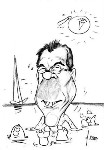Epilogue
The Epilogue is a MPEG input document kindly provided by Chad Fogg, containing a report from a future society, thousands of years from now. This society developed the astonishing capability to communicate backward in time, using the CERN accelerator laboratory in Geneva. Following several misinterpretations, the report was decoded from an analysis of inexplicable deviations in particle collisions, the modulation means by which messages are sent to us from this future society. The report describes that archaeologists from this society discovered a trove of MPEG standards documents buried in the ruins of the ISO and ITU headquarters in Geneva, referred to as the "Geneva Stone archive". They made an effort to understand the documents and the community that produced these documents; while several of their interpretations seem amazingly correct, they seek clarification on several specifications.
In the trove, they also found several chambers. One chamber contained a transparent preservation case with a body in which the limbs and organs have been replaced by cyborg parts. For example, his current cyborg eyes and mouth are capable of emitting heat rays. The large golden label below the case reads "Convenor". After some time, they discovered this body is still alive in some sense; when heated discussions took place near the body, the fingers started to twitch; the more intense the argument was, the stronger the twitching grew...
A few excerpts from the Epilogue are presented below.
<...>
Most of our scientists had outright dismissed this visual pattern notion since the visual codes would have been highly statistically biased to a few input signals, rather than the actual diffused light scattered off objects in the polluted environment of the Digital era. We now understand, thanks to Geneva Stone, that the former to be the case, documented in the standards communications archive as the test input video sequence "Flower Garden", “Table Tennis” and others that typify the Digital’s strange preference for indulging in contrived scenery consumed during all of their free time.
We realized later that we could decode "MPEG-2" media fragments, despite the lack of any Geneva Stone, due to its simple syntax and self-evident semantics. However, one major setback persists: we are still unable to decipher the book of "SVC" (Scalable Video Coding), despite now having an intact specification to work with and several "example bitstreams.” Curiously, no waste heaps appear to contain stored bits encoded with this “SVC” syntax.
We would like to apologize to the world community for our attempts to solve the “SVC” puzzle, which resulted in a take-over of the universal computing cloud. Thankfully, black hole prevention circuits triggered just in time. We may need to rethink our understanding of Digital humans and, indeed, the entire laws of physics, since the authors of the “SVC” specification must have somehow possessed cognitive abilities that exceed the logic of our most capable quantum supercomputers that now account for the majority of our planet’s mass, powered by the redirected energy of our sun.
<...>
Although one is left with a strong impression from reading their input documents that these creatures believed data could be organized and treated as a neat orthogonal, linear system (often they cite their prophet "Shannon" in this context), there are nonetheless many contradictory instances where, for example, packet headers in the vaunted "Systems" layer are locked by complex rules to elements that occur in the separate, but lowly video domain. The Digital’s standards appear to devote much language to compensating for the logical challenges of such orthogonal-yet-not-orthogonal alignments. One protocol was highly persistent and still influences us today, over 700,000 years later. Its recovery from the Geneva Stone finally provides a clue to where our genetic 188-byte packet length preference comes from! (Many machine cults will be disappointed to learn it is not, after all, a golden number or cosmological constant upon which they founded their religion).
<...>
Convenor-bot isn’t just a machine possessed by a human mind. Originally he was fully human, but over a period of a hundred years of escalating meeting intensity, cyborg parts that performed similar functions gradually replaced each of his organs and limbs. It is difficult to believe that the speech and expression skills from his original organic face was as effective at influencing delegates as the heat rays emitted from his current set of cyborg eyes and mouth. Still, there is much about humans we do not yet understand.
<...>





